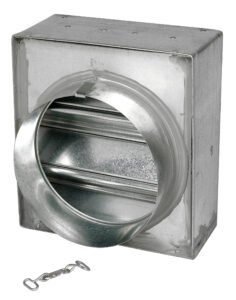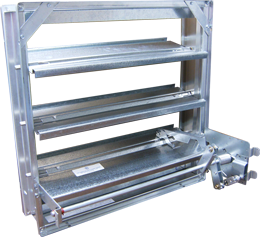In an HVAC system, fire dampers play a crucial role in fire safety by restricting the spread of flames, smoke, and hot gases through ductwork. Here’s a breakdown of the two main types of fire dampers used in HVAC systems:
-
Static Fire Dampers:
-
Function: These fire dampers operate based on temperature alone. They are designed to close automatically when surrounding air reaches a predetermined high temperature due to a fire.
-
Mechanism: Static fire dampers typically rely on a fusible link, a heat-sensitive element holding a spring-loaded closure shut. When the surrounding air reaches the link’s activation temperature (around 165°F or 74°C), the link melts, releasing the spring tension. This allows the damper blade to fall due to gravity, effectively closing the duct opening.
-
Location: Static fire dampers are generally installed in horizontal barriers within the ductwork, such as ceilings or floors. Since they don’t require external power to function, they are suitable for locations where the HVAC system might shut down during a fire.

-
Limitations: Static fire dampers have limitations. They cannot respond to smoke alone and rely solely on high temperature to trigger closure. Additionally, if the air pressure within the duct pushes against the closed damper blade, it might not create a perfect seal.
-
Dynamic Fire Dampers:
-
Function: Dynamic fire dampers offer a more advanced level of fire protection. They are designed to close automatically upon detecting high temperatures or smoke.
-
Mechanism: These fire dampers use a combination of a fusible link and an electrical connection to a fire alarm system. When high temperature activates the link or the fire alarm system detects smoke, the damper receives an electrical signal to close. A spring-loaded mechanism or a motorized actuator then shuts the damper blade, blocking the duct opening.

-
Location: Dynamic fire dampers are typically installed in vertical barriers within the ductwork, such as walls. They are well-suited for locations where the HVAC system might remain operational during a fire, as they can respond to both heat and smoke signals.
-
Advantages: Dynamic fire dampers offer several advantages. They can respond to smoke signals for faster closure, and the electrical connection ensures a more positive seal against air pressure within the duct.
Choosing the Right Fire Damper:
The selection of the appropriate fire damper type depends on several factors, including:
- Location of the damper in the ductwork (horizontal vs vertical barrier)
- Fire safety codes and regulations in your area
- Operation of the HVAC system during a fire (on or off)
Consulting with a qualified HVAC professional or fire safety expert is crucial to ensure you have the right type of fire dampers installed in your HVAC system. They can assess your specific needs and recommend the most suitable fire dampers for optimal fire protection.
Looking to install a commercial HVAC System or Duct work in your Business Area?
Contact Vipul Ac to learn about our HVAC Service
Call +91 9825636606 Today.
